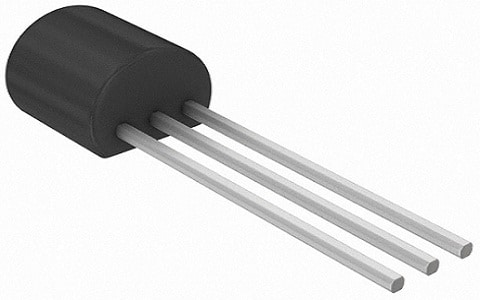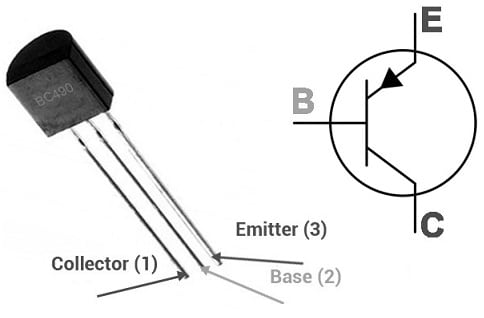The transistor is the most significant electronic component in designing various electrical and electronic switching and amplifier circuits. The transistor includes three terminals where the central terminal is the base and the remaining two terminals are the emitter and collector. The doping region of the emitter terminal is less as compared to the collector however larger as compared to the base. Transistors are used everywhere almost from relay driver circuits to very complicated motherboard circuits. These semiconductor devices are classified commonly as BJTs, FETs used in the development of computers, radios, calculators, electronic gadgets, etc. This article discusses an overview of the BC490 transistor, pinout, specifications, and its applications.
What is a BC490 Transistor?
The BC490 is a general-purpose PNP transistor available in the TO-92 package, used to switch electronic devices with a fairly high voltage, so this transistor is perfectly suitable for mainly switching applications. The VCE of this transistor is -80V, a continuous collector current is -1A DC and power dissipation is 625mW.
The gain of this transistor ranges from 40 to 160, determining the transistor’s amplification capacity. The highest current that can be supplied throughout this transistor is 1.5 amps. This transistor is an ideal choice for mainly moderate-high voltage applications combined through the gain value.

BC490 Transistor
While looking for a transistor’s characteristics it is also important to look into a few points on how to choose it. To know how to choose click on – How to Select a Transistor.
Working
Whenever the BC490 transistor is biased, then it permits 1A of a maximum current across the Collector-Emitter (CE) Junction which is called the saturation state. Suppose driving a load that uses >1A current that may harm the circuit permanently. In the design procedure, you need to be conscious that the highest current dissipation of this is 625W. When the current supply at the base terminal is removed then the transistor becomes completely off, so the transistor in this stage works in its cut-off region, thus there is no flow of current throughout the CE junction.
In normal circumstances & exclusive of external control there will be a +ve voltage coming into view at the base terminal of the transistor. According to the working principle; having a +ve voltage at the base terminal will put this transistor in a higher resistance condition. So to turn the device completely, a small amount of current must be supplied from the base terminal. To supply 1000mA of current throughout the collector terminal to the emitter, 50mA of current is required to flow throughout the base terminal of the transistor.
BC490 Transistor Pin Configuration:
The pin configuration of the BC490 transistor is shown below. This transistor includes three terminals an emitter, a base, and a collector which are discussed below.

BC490 Transistor Pin Configuration
- Pin-1 (Collector): The collector terminal collects the emitted electrons from the emitter.
- Pin-2 (Base): The base terminal helps control the transistor biasing.
- Pin-3 (Emitter): Electrons emitted from the emitter into the first PN junction.
Features & Specifications:
The features and specifications of the BC490 transistor include the following.
- BC490 is a PNP Bi-polar transistor.
- It is available in the TO-92 package.
- This transistor includes three terminals.
- Maximum DC gain or hFE is 400.
- Its continuous collector current IC is 1A or 1000mAmps.
- The transistor code is BC490.
- The type of transistor is BJT.
- The polarity of polarity is PNP.
- The material of the transistor is Silicon.
- The emitter to base voltage or VBE is -4Volts.
- Maximum base current or IB is 50mAmps.
- Collector to base voltage |Vcb| maximum is -80 V
- Collector dissipation is 0.625 W.
- The transition frequency or Tf is 150 MHz.
- Collector capacitance is 9pF.
- The maximum collector-to-emitter voltage or VCE is 80V.
- Operating & storage junction temperature ranges from -55 to +150 °C
- The maximum emitter to base voltage is VEB – 5Volts.
- Its forward current transfer ratio or hFE value is 60.
Equivalent & Complementary Transistors
Equivalent BC490 transistor is; 2N564, 2N3906, BC177 & BC488. The complementary BC490 PNP transistor is the BC489 NPN transistor. SMD Versions of this transistor are; FMMTA56 in SOT-23 & KST56 in SOT-23.
Replacing a suitable transistor in any circuit based on requirement is very important. To know how to replace it, please refer to this; Replacing Transistors in Electronic Circuits: Factors and Considerations.
BC490 Transistor Circuit
A simple transistor circuit is shown below. This circuit shows how the transistor performs whenever the base terminal is connected to the GND & when it is connected to the 12V supply. The required components to make this simple circuit mainly include; a 12V supply, BC490 transistor, LED, Resistors R1 & R2–10K, and R3 – 330.

BC490 Transistor Circuit
Working
Generally, transistors are current-controlled devices thus a little current is required to turn them ON. The base current for the BC490 transistor is < 50mA because it is a PNP transistor, it will be turned ON whenever the base terminal is connected to the GND. This transistor will be turned OFF whenever a +ve voltage is provided to the base terminal of the transistor.
Whenever the transistor is turned ON by connecting simply the base terminal to the 12V supply then BC490 will stay on except the voltage supply at the base terminal achieves below the cut-off voltage like 0.7 to 0.9V. The transistor’s base terminal cannot be left floating or else there could be fake triggering, that may lead to problems within the circuit. To resolve the problem we need to connect pull-down resistors. So, a 10K resistor is utilized to pull up the base terminal of the transistor toward VCC.
Connecting a base resistor to the base terminal of the transistor is mandatory to avoid it being damaged. Please refer to this link for; Choosing Base Resistance for Transistors in Electronic Circuits.
Applications
The applications of the BC490 transistor include the following.
- BC490 transistor is used in amplification of signal.
- It is used as a switch, in sound amplifier circuits & sound systems as amplifiers.
- This transistor is used wherever moderate-level switching volts are necessary.
- It is usually used as a switch because of its good function & less expensive nature.
- This type of transistor can be utilized to switch devices through a moderately higher voltage.
- This PNP transistor is used in consumer, industrial, and simple switching applications.
- It is used to design microphone preamplifiers, relay drivers, signal amplifiers, lighting systems, audio amplifiers, etc.
- This transistor is used widely in power management systems, signal processing circuits & consumer electronics.
There are certain aspects that one should consider while choosing a transistor . Please select on the link
The transistor can also be interfaced with a microcontroller. Before using any of the transistors first we need to know how to choose a transistor for a circuit. Click this link How to Select a Transistor to know about it.
Please refer to this link for the BC490 Transistor Datasheet.
Thus, this is an overview of the BC490 Transistor, pinout, features, specifications, circuit, working, and its applications. The BC490 is a PNP general-purpose transistor where N-type material is arranged in between two P-type materials. This type of transistor is made with silicone (or) germanium. The features of this transistor help to utilize in different operations wherever higher voltage is required. Here is a question for you, what is BC457 transistor?